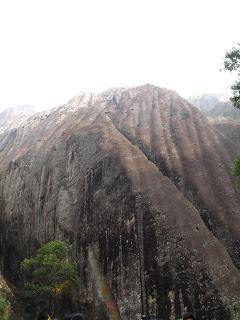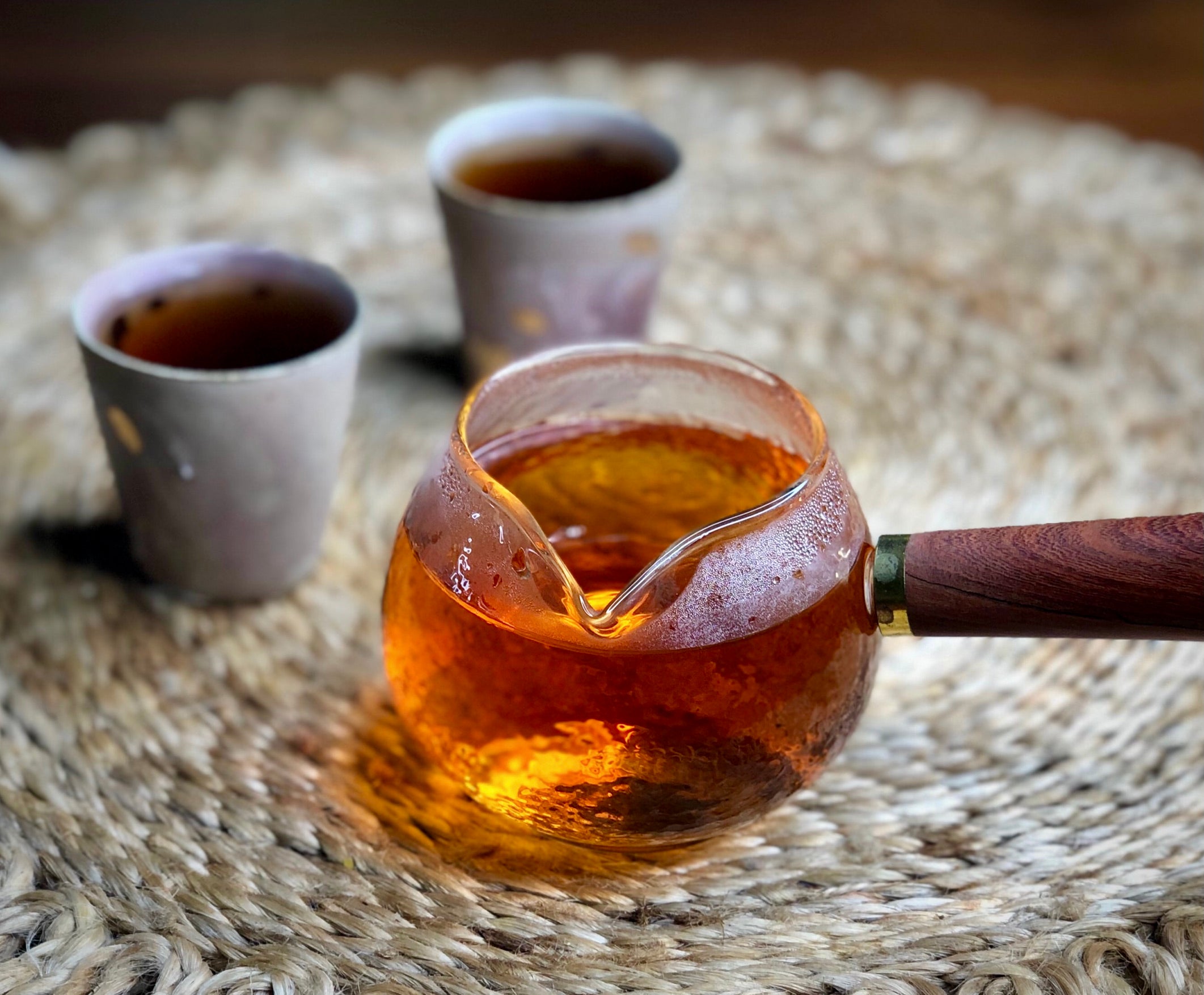Mountain legends & modern myths, enrich the appreciation of humble tea leaves.
After a full day of tea appreciation, I was drunk on tea. We tried to take our leave but Mr. Yu insisted we join him for dinner, where he served a homemade alcohol infused with plums. The dinner party was composed of several members of Mr. Yu’s Buddhist study group, and a charismatic investor from Fuzhou. Several courses of poultry, fish & local vegetables followed. Completely stuffed, we retired to the tea-room for some of the most amazing teas I have ever tasted. That is no exaggeration. He started with the da hong pao which won the gold medal at the Shanghai Expo. It sells for $200 per 50g!
Mr. Yu then served another rare & spectacular tea called mei zhan (梅占). What made it special was the fact that it had been picked & processed in 1996. The overseas owner had stored 18 boxes away in a warehouse where they were forgotten for 15 years. When time came to clear out the warehouse, Mr. Yu’s friend had insisted he come along to inspect these old boxes. With zero expectation, Mr. Yu described how he had been transported away by the sweet heady aroma of the leaves, miraculously enhanced by time. He bought the lot.
I love a good story behind my tea. It just adds another dimension of appreciation to the liquid gold. When we drank the mei zhan we were all lost for words. It was amazing, even perfect, but such crude and common words could not do it justice, so we said nothing.
“A good tea speaks for itself” Mr. Yu said sagely.
Our last tea of the evening was a gold-medal rou gui. Mr. Yu elaborated how the unique terrain of wuyishan shaped this superb tea. The rainwater leaches minerals out of the cliffs, which means the tea bushes growing near the limestone bluffs tastes different from the bushes that grow in the middle of the valley. The blade like cliffs also shield adjacent bushes from wind & sun which affects the chemistry of their leaves. He recounted how during a farm visit, he discovered some rou gui trees growing up against a large rock cliff. The land owner had mistaken them for the more common shui xian, and had neglected to harvest them. Without pruning or plucking, these trees had grown wild & tall. Mr. Yu described how he had excitedly plucked and rushed home to process the leaves. The tea produced from these trees was uniquely complex & fragrant. You could taste the freedom of the tree, rooted in this sheltered spot yet tall enough to reach into the sun & wind.
One of the guests told us about his Chinese culture center in Guangzhou, where he trades aged Puer and collects Chinese art. He boasted that he could taste any puer and tell us which mountain it came from, and even which side of the mountain it grew on! We heard a sad story of an investor who asked him to assess a puer collection which he had bought for RMB 4million. It wasn’t terrible tea, but the flavor & raw materials did not match the age it was claimed to be. He didn’t have the heart to bluntly tell this man he had been conned on such a massive scale, so he merely hinted that more of his losses could be recouped if he waited a few more years.
As the majority of his guests had come to Wuyishan for a Buddhist retreat, conversation invariably turned to religion. The Buddhist students talked excitedly about their life in the monastery on top of the mountain, where they greet the sun each morning, and spend their days studying Buddhist texts and meditating. They are modern day pilgrims, travelling from all over China to seek enlightenment on this mountain peak. I was touched by the sincerity of their world perspective. They reject materialism for a life of simplicity & contemplation. One young girl told me the body is just a temporary shell, a mere vehicle to carry her through this life into the next.

The sheer limestone cliffs of Wuyishan
"Tea should be photographed in the landscape where it was grown" - Mr. Yu
The next day, Mr. Yu took us up the mountain to see the original Da hong pao bushes. As he is a local tea producer, he does not have to pay park entrance fees after 4pm. By the time we reached the bushes it was nightfall, and there were none of the usual tourist hordes that plague mountaintops in China. The 3 mother bushes of Da hong pao grow on a ledge about 6m up the cliff face.

The original "Big Red Robe" mother trees
The 350 year old bushes are not much to look at, they are actually quite small and scraggly, yet these hardy little trees produced China’s most highly priced oolong. All the da hong pao we drink today was grown from cuttings & seeds taken from these bushes. According to online reports, the mother bushes only yield about 100g of tea a year. This is reserved for state gifts, and occasionally auctioned off for ridiculous prices (ie. 20g for $25,000). It is said that when Nixon extended the olive branch of détente to China in 1972, Mao gave him in exchange, 50g of da hong pao picked from the mother bushes. Nixon thought this meager gift to be a bit stingy, until Zhou En Lai explained that Mao had just given him half the nation’s treasure!
As the chill of night fell around us, Mr. Yu bought a bag of steaming eggs, hard boiled in tea. We sat under a straw shack, peeling the boiling hot eggshells and devouring them with our hands like primitive cave dwellers. Surrounded by tea bushes, atop a holy mountain, I had an epiphany. There is something mythic about Wuyishan, its eroded peaks, mute witness to a millennia of nature’s drama. What stands before you is not tea, but the stuff of legends.
We descended back down the stairs to the carpark in pitch darkness.

The stairway to heaven
On my final day in Wuyishan I climbed up to the "heaven travelling peak" (武夷山天游峰), passing through a forest with ruined pagodas, caves & tea plantations tucked inbetween sheer red & grey cliffs. The steep ascent took my breath away, the final leg up the spine of a razor sharp ridge was magnificent. Far below me, tourists puffed out in fluorescent life jackets floated down the river in a column of bamboo rafts.
Hiking through the national park completed my tea pilgrimage. Seeing the bushes of da hong pao, rou gui and shui xian, it was easy to see how a single mountain range can harbor a range of microclimates that encourage adaptation & shape the famous tea varietals of wuyishan. No doubt selective breeding & variations in processing play a big role, but nature did a lot of the hard work upfront.
Nothing beats personally visiting the source of origin and buying tea directly from the producer. Now everytime I drink a roasted oolong, I am transported again to that wondrous place, where tea bushes grow out of sheer cliff faces, and tendrils of mist cling to the mountain top.

Rou Gui bushes growing amidst the mythic landscape of Wuyishan

